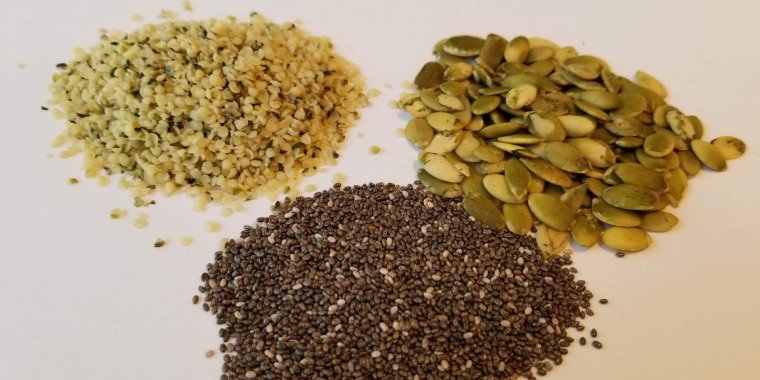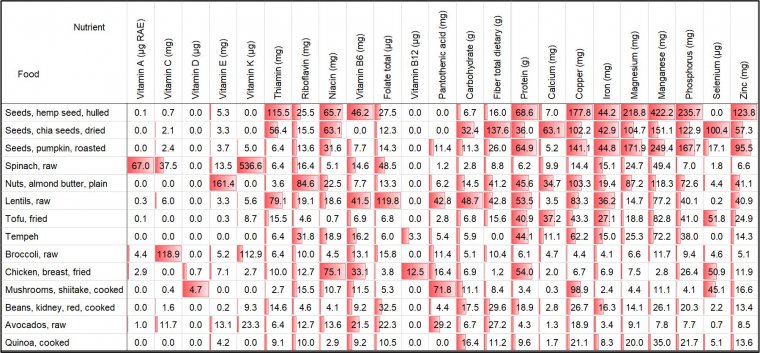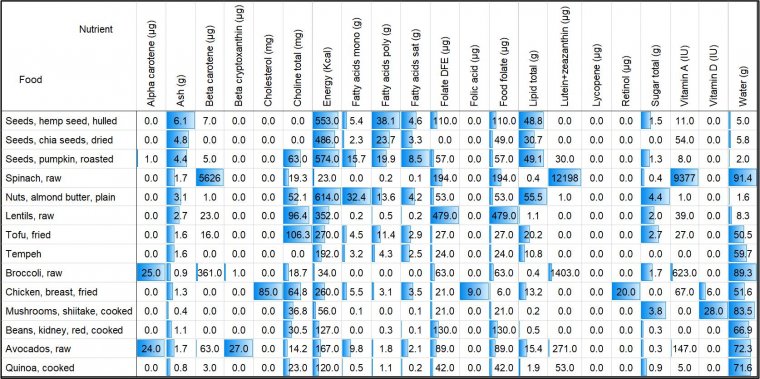| News / Science News |
Sources of vegetarian proteins
DANIEL ŞTEFĂNIŢĂ | JUNE 7, 2020
Vegetarians are many times told that they may not get enough protein. A concern that can be eliminated with a bit of research based on the USDA food database that provides the nutritional content of thousands of foods, and RDA (Recommended Dietary Allowance) established by Institute of Medicine’s (IOM) Food and Nutrition Board (FNB).

Hemp, pumpkin and chia are among the most nutritious seeds. Photo: D. Ştefăniţă
So, here is a small list of vegetarian sources (Table 1), and for comparison, showing also the content of chicken meat. The table is sorted by the average content across all RDA nutrients.
On top of the list are the hemp hearts. They come from the Cannabis sativa plant, and are some of the most nutrient rich seeds available.
Hemp has a high content of thiamine (or vitamin B-1, which helps the body generate energy from nutrients), iron (component of hemoglobin), magnesium (involved in protein formation, nervous system regulation and many others), phosphorus (for strong bones), manganese (used to make energy, protect cells from damage, for strong bones, reproduction, blood clotting, healthy immune system), and zinc (immunity and metabolism).
Protein content is higher than meats like chicken or beef. Hemp seeds are relatively high in calories (energy) but low in carbohydrates. Although hemp is a variety of cannabis plant, it doesn’t contain THC (tetrahydrocannabinol), the psychoactive constituent of cannabis. It is safe and legal to consume.
Chia seeds beat hemp on fiber, calcium and selenium content. Dietary fiber is associated with digestive health and reduced risk for heart disease, stroke, hypertension, certain gastrointestinal disorders, obesity, type 2 diabetes, and certain cancers.
Calcium is needed for strong bones, and proper functioning of muscles and nerves. Selenium is a constituent of some proteins important for reproduction, thyroid hormone metabolism, DNA synthesis, and protection from oxidative damage and infection (source: NIH, Office of Dietary Supplements).
Spinach is rich in vitamin K, which is important for blood clotting and healthy bones.
Nuts are a good source of vitamin E and riboflavin. Vitamin E is an antioxidant, helping to protect cells from the damage caused by free radicals. Riboflavin, also called vitamin B2, is important for the growth, development, and function of the cells. It also helps turn the food we eat into energy.
Lentils are a great source of folate, which the body needs to make DNA and other genetic material, and also for cells division.
Tofu is a cheese-like product made by curding soymilk and then pressing the resulting curds into solid white blocks of varying softness; it can be silken, soft, firm, extra firm, smoked, deep-fried or grilled.
Tempeh or tempe is originally from Indonesia. It is made from fermented soybeans with a fungus (Rhizopus oligosporus). It is served fried, baked or steamed.
Fried tempeh has a meaty texture and the flavor of fried chicken or fish. Because it contains the whole bean, tempeh contains more protein than tofu. It also contains gut-friendly prebiotics and probiotics as a result of the fermentation process.
Broccoli has high content of vitamin C, which in the body acts as an antioxidant. The body also needs vitamin C to make collagen, a protein required to help wounds heal.
In addition, vitamin C improves the absorption of iron from plant-based foods and helps the immune system work properly to protect the body from disease (source: NIH, Office of Dietary Supplements).
Shiitake mushrooms fill the gap for Vitamin D and Panthothenic acid. Vitamin D is needed for calcium absorption and immunity, while Panthothenic acid (or vitamin B5) is important for many functions in the body, especially making and breaking down fats.

Table 1: Nutrient % of RDA for females 31-50 years old, provided by 100g of several foods (Source: USDA)

Additional nutrients, not listed in the RDA (Source: USDA)
Veggie burgers recipe
Ingredients
• 900g shiitake or portabella mushrooms (or both), chopped
• 120g rolled oats
• 50g shredded parmesan
• 40g breadcrumbs
• 50g chia seeds
• 50g hemp seeds
• 3 eggs, beaten
• some fresh parsley, chopped
• 100g white onion, chopped
• 6 cloves garlic, crushed
• 1 teaspoon dried oregano
• 1/2 teaspoon salt
• 1/2 teaspoon black pepper, ground
• 4 tablespoons olive oil
In a pan add the oil and sauté the mushrooms, onions, and garlic over medium heat until the liquid boils off and the mushrooms turn a bit golden. You may save some of the liquid to mix with the other (dry) ingredients.
Mix the remaining ingredients in bowl. Beat the eggs and mix in, making sure the composition is uniform. If too dry, add some of the mushroom liquid.
Split the mixture in about six parts and shape the patties about 2 cm thick.
Heat the oven to 180°C (360°F). Place the burgers on a non-stick tray and cook for 20 min, then turn and cook for another 10 min. At the end, turn the broiler on for 3-4 minutes to give the burgers some golden color.
Serve with the preferred side dish.
YOU MAY ALSO LIKE





